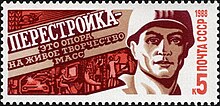
Back Perestroika Afrikaans Perestroika ALS بيريسترويكا Arabic Perestroika AST Perestroyka Azerbaijani Perestroika BCL Перабудова Byelorussian Перабудова BE-X-OLD Перестройка Bulgarian Perestroika Catalan
Perestroika, which means "restructuring" in the Russian language, was a series of changes to the structure of the Soviet economy. Soviet leader Mikhail Gorbachev started the policy in 1986.[1] This happened only a few years before the Soviet Union dissolved into 15 new countries. Many historians argue that it was a major reason that the Soviet Union fell apart. Perestroika was introduced around the same time as Gorbachev's "glasnost" reforms, which loosened restrictions on the media and allowed for criticism of the government. It was the first time such changes were implemented in the Soviet Union, and uncovered a lot of secrets about how the Soviet system operated. It also uncovered events which the public were unaware of, such as Chernobyl occurring three days before any announcement was put out, or the deals that Stalin made with Hitler during WWII.

The Soviet Union was ideologically a communist country. The economy was centralised and the means of production owned by the government. People did not own their own land or businesses. Under perestroika, some people were permitted to own their businesses.[2] Gorbachev's main goal of perestroika was to repair the Soviet economy, which had been stagnant for decades and upon his election was starting to decline. However, Gorbachev's reforms did not have the desired impact and many people attribute the dissolution of the Soviet Union as Gorbachev's fault.
- ↑ "Perestroika". ibiblio.org. Retrieved May 2, 2010.
- ↑ "Russia-Unforeseen Results of Reform The Perestroika Program". mongabay.com. Retrieved May 2, 2010.